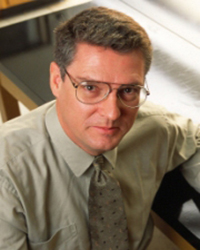
A Florida State University College of Medicine biomedical sciences professor has been recognized as having one of the most influential structural biology laboratories in the world.
Michael Blaber has been named No. 36 in a ranking of top scientists in the field of structural biology by the Ion Channel Media Group, a media and publishing company that controls more than 50 internet portals geared toward professional scientists and business people. The rankings reflect how relevant a lab’s work is to the worldwide scientific research community, based on the number of citations and downloads from online databases PubMed Central Database and the Protein Data Bank. Each article’s publication date also played a role in the rankings formula. To view the rankings, visit www.molecularstructure.org.
Blaber, who earned an international patent Sept. 29 for his development of a mutant protein that may soon aid patients with chronic heart disease, is in good company with his lab’s ranking. Blaber’s neighbors on the list include Nobel laureates Johann Deisenhofer (No. 31) and Robert Huber (No. 34); Wolf Prize winner Ada Yonath (No. 38); and myriad members of the International Academy of Science.
“The CEO of the company (ICMG) contacted me saying that they’d established this database and that our name was included in there,” Blaber said. “I was pretty surprised.”
The media group’s ranking has not been the only measure of Blaber’s achievement this past year. He has received grant awards from the National Institutes of Health and the American Heart Association, for $219,000 and $264,000, respectively. In addition, at the end of August Blaber accepted the E.K. Frey-E. Werle Commemorative Gold Medal in Munich, Germany, for his work with kallikrein proteins. The medal honors scientists who have made outstanding contributions to understanding the role of the kallikrein-kinin system and who have had significant influence over related health and disease research.
Despite Blaber’s success in various subfields of biomedical science, it’s mostly his work on protein mutations that led to the lab’s ranking. Blaber originally began studying the FGF-1 protein structure (a protein important to the human body) in 1994, when he arrived at FSU’s Department of Chemistry. Since then, Blaber has focused on manipulating the protein’s basic structure into mutations of itself, in an effort to create a protein that has all of FGF-1’s useful qualities yet without stability issues.
“I think our ranking would be based upon the sum total of all the structures we’ve deposited in the structural protein data bank,” Blaber said. “And I would think part of the reason why we’re on that list is because of the productivity we’ve had over the years, in addition to the interest in the individual structures that we’ve solved.”
In September, Blaber received a patent on the first of his lab’s successful mutant proteins, first constructed in 2005. These mutants may soon provide a treatment for heart disease patients who would not benefit from bypass surgery or an angioplasty procedure. Currently, those heart patients have no alternative, and essentially they are sent home helplessly facing their looming death.
But now, with the patent, the lengthy clinical trials process can soon get under way. The therapy, called therapeutic coronary angiogenesis, involves an FGF-1 mutant being injected into the specific areas of a patient’s heart that house the thorny blockages that elude traditional treatment. The mutants cause the patient’s body to grow new blood vessels, which strengthen blood flow.
Blaber’s lab has produced several other FGF-1 mutants that are in the process of being patented. One company, Cardiovascular Biotherapeutics, has shown interest in distributing these proteins, but that process can get off the ground much more easily when more of the patents come through, according to Blaber. The process takes years, but the first patent inspires hope that further developments will be in the project’s not-too-distant future.




